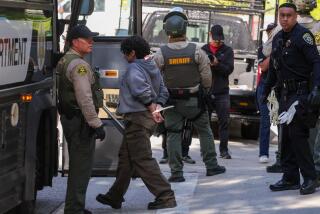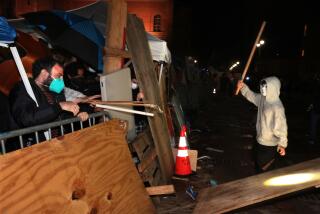Mob Mentality Issue Raised at Denny Trial : Courts: Defense seeks to allow UCLA expert to testify before the jury. In a hearing, he talks of ‘group contagion’ dominating during a riot.
Mob behavior during a riot is spontaneous, a UCLA professor testified Tuesday, advancing a theory that challenges a central prosecution position in the trial of two men accused of attempting to murder trucker Reginald O. Denny.
Prosecutors have said the defendants, Damian Monroe Williams and Henry Keith Watson, acted in concert with others at the intersection where Denny was beaten, targeting Latino, Asian-American and Anglo motorists for attack while allowing African-Americans to pass unharmed.
For the record:
12:00 a.m. Sept. 23, 1993 For the Record
Los Angeles Times Thursday September 23, 1993 Home Edition Metro Part B Page 3 Column 1 Metro Desk 3 inches; 81 words Type of Material: Correction
Denny trial--Because of an editing error, a story published Wednesday about the Reginald O. Denny beating trial mistakenly substituted the name of one witness for another. It was revealed on cross-examination of Norman I. Perle that he, not Dr. Armando Torres Morales, had made false claims on his resume and had lied about his academic credentials. Morales is a professor of psychiatry, social work and biobehavioral sciences at the UCLA School of Medicine. He holds a bachelor’s degree in sociology from Cal State L.A. and master’s and doctoral degrees in social work from USC.
Williams was a leader who directed traffic and selected some of the victims, indicating he behaved according to a plan--or had a specific intent--to assault people who were not African-American, prosecutors maintain.
Prosecutors must establish intent to prove attempted murder and aggravated mayhem, charges with maximum sentences of life in prison.
Only Williams, 20, is charged with aggravated mayhem--intentionally and permanently disfiguring a victim. He and Watson, 29, also are charged with assaulting or robbing seven other people besides Denny at Florence and Normandie avenues as rioting erupted last year.
The jury was excused from the courtroom as Armando Torres Morales of the UCLA School of Medicine testified at a hearing to determine whether the panel should listen to his observations on mob behavior. The hearing is to be completed today, and Superior Court Judge John W. Ouderkirk will decide whether the jury should hear the testimony.
Rioters at Florence and Normandie made no conscious choices to become part of the group, or to stay out of it, he said. There can be extremely positive or extremely negative behavior because individuals in the crowd assume different roles, he said.
“Some assume extremely heroic roles,” he said, citing good Samaritans who rescued victims. He said the rescuers might not have risked their lives had they thought about it beforehand.
Social scientists do not know what determines if a person acts positively or negatively as part of this “group contagion,” he said.
At the 1968 Democratic convention in Chicago, for example, police officers--individuals seemingly of high moral standards--lost control and acted out of group contagion when white, middle-class demonstrators began bombarding them with urine and feces, Morales said.
Sigmund Freud called such riots mass hysteria, Morales said.
A typical reaction after mob behavior, he said, is: “I can’t believe it was me.”
The group contagion at Florence and Normandie was triggered by not guilty verdicts in the state trial of four officers in the Rodney G. King beating trial, Morales said, and escalated to four days of rioting, arson and looting.
Deputy Dist. Atty. Janet Moore argued that it would be absurd to allow Morales to attribute the defendants’ behavior to sociological factors.
If Morales cannot relate the group contagion theory specifically to the defendants, he has nothing relevant to offer, Moore said.
Attorney Edi M. O. Faal, who represents Williams, said outside court that Morales is very important to his case. “He will show that people at the intersection were caught up in a frenzy. There was no time to develop specific intent to commit any crimes.”
In afternoon testimony before the jury, Moore exposed on cross-examination that Morales had made false claims on his resume and had lied about holding a two-year degree from Los Angeles Valley College.
Faal had called Norman I. Perle to authenticate still photos Perle had made from videotape. But after Perle testified that he had enhanced the photos, Moore launched an assault on his credentials.
Perle could not define many basic terms used in image processing--terms a prosecution witness had meticulously explained last week in testifying how he had enhanced some photos used in the trial.
More to Read
Sign up for Essential California
The most important California stories and recommendations in your inbox every morning.
You may occasionally receive promotional content from the Los Angeles Times.










